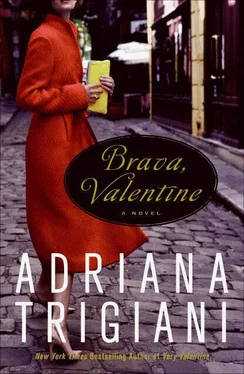“I am Roberta Angelini.”
I turn to face my cousin for the first time. She extends her hand.
“I’m Valentine.” As I look into her eyes and take in her face, I lose my ability to speak. “You’re…Roberta?”
A tight smile breaks across her face slowly.
Roberta Angelini is beautiful, and to my surprise, she is black.
As she takes me in, I can tell that I am, on the other hand, exactly what she was expecting.
“You’re shocked,” she says, placing her hands in her apron pockets.
“I am.” I did a poor job of hiding my surprise. “I didn’t know you were black.”
“And yet I knew for sure that you would be white.”
As we look at one another, obvious family traits become apparent. Roberta’s nose is like my sister Jaclyn’s: small, with a short bridge that comes to a very exact point. Her café-au-lait skin is smooth and flawless, like my mother’s. She wears her hair pulled off her face ballerina style, in a high ponytail looped into a delicate bun, like Tess. Her eyes tilt upward, but the lids are languid. She is trim and small.
I long to call Gram and tell her the news, if this can even be called news.
“Before we talk business,” Roberta says, “I will show you the factory.”
As I follow her, I picture the members of my family in a group shot-I line up the cream-colored people like wooden pins in a bocce set, face by face, build by build, baby by baby. We have Italian (Angelini, Roncalli, Cavalline, Fazzani) and Irish (McAdoo) under an American tarp, and the lone Japanese cousin who married my dad’s nephew, but that’s as much diversity as we got-until now.
“This is production,” Roberta says, opening the door. I follow her into the main room, an enormous airplane hangar of a room, with distressed wooden floors that buckle under the weight of rows of machines.
The noise that was a low and steady hum in the office now blares at full force inside the factory. The machines grind, pulse, and whir in rhythmic bars of sound. Roberta shows me the first section of machines, which resemble large sewing machines. The base of the machines has heft, curves of iron with a silver wheel, which the operator spins to and fro to control the speed.
The operators sit behind their machines on small rolling work stools. They assemble the separate leather pieces cut from a pattern, and then sew the shoe’s upper together, tongue to vamp, with deft movements that come from years of rote practice.
The operators move the pieces under the thick needles as they pulse up and down, the speed of the needle controlled by a pumping action made with operator’s knee to the pad affixed under the worktable. A foot pedal on the floor serves as a brake. When a seam is complete, the operator pulls the shoe, snips the thick thread, and sends it down the row to the next operation.
A wooden last, or shoe model, is inserted into the partially assembled shoe. Operators toss the shoe and last into a bin, which is wheeled to the next section of operations.
A row of more compact versions of the sewing machine is used to sew the welt to the shoe. The shoes then move to the next fleet of machines, where the heels are attached by a press, using sleek nails and cement. A trimming machine, which employs small and speedy blades, trims away excess binding and leather, cutting the shoe to size. The toe caps are stamped on a set of machines that look like upright hammers that pulse back and forth.
A large rolling machine works the leather and makes it pliable. I am envious of the machine, which uniformly stretches and presses the leather simultaneously. I roll the leather by hand, and it takes me hours to get it loose enough to work with, and to sew. Hand-rolling is a painstaking process that takes hours; here, it takes mere minutes, and the results are just as beautiful.
The roller, with its shimmering, smooth wheels and flexible mount, is the machine that put the custom shoe business in the museum.
Workers operate small drills with fine points that perforate the oxford with holes for laces. A small hand-held press snaps the metal grommets into place. Then a piping machine attaches trim, while a buttonholer creates finished seams around the grommets. Once these tasks are completed, and the shoe has been passed down the line, the operator tosses the shoe into another set of deep cloth bins with wheels.
I follow Roberta into finishing. The physical space fans out to accommodate machines that serve several functions to complete work on the shoe. Here, some of the operators stand to do their work, and like the rest of the workers in the factory, they move quickly. There are wooden lasts affixed on poles at eye level, where a worker takes the shoe, places it on the last, and works the pliable leather by hand to remove any creases and to check the accuracy of the size and measurements.
In our shop, I use a small brush machine, operated by foot pedals, to buff the leather. Here, the same idea is expanded to accommodate hundreds of shoes. A long conveyor belt with brushes attached on either side runs through the center of the finishing department. The finished shoe is fed onto the belt, held in place by the movement of the brushes.
The completed leather shoe, minus the laces, is anchored by the thick sable brushes and polished to a high gloss by the time it reaches the far end of the belt. It would take me an hour to achieve the same level of shine manually.
At the far end, the freshly machine-polished shoe drops into a bin, where it is checked by hand and sorted into separate cubbyholes in a large, freestanding wooden grid, shaped like an open egg crate. Workers are positioned on either side, one loading from the conveyor and one on the other side retrieving the finished shoes, to inspect them before boxing them to be shipped.
“Is this similar to your shop?” Roberta shouts over the noise.
I shake my head that it’s not. I hold up my hands to indicate something much smaller. “This is my factory.”
“Many years ago, we were the same. But we have expanded several times, and now we employ over two hundred people.”
“I can see that. Where do you do the cutting?”
She motions for me to follow her. We pass through the finishing department and climb a small flight of stairs to the second floor.
The cutting room resembles an oversize operating room in a hospital. Bright honeycomb-shaped work lights hang over one long table that extends down the center of the room.
Over the table, an oval track extends the full length of the table. A large circular saw for cutting leather is attached to the track. The serrated blade peeks out from a metal sleeve, which is strapped to a rig that has a full range of mobility in the hands of the cutter.
Assistants layer the leather, in flat sheets, methodically on the table. The leather is about five layers deep, separated by layers of sheer pattern paper. The assistants step back, while the presser comes forward to smooth the pattern paper against the leather with a flat board.
The head pattern cutter pulls a pencil from behind her ear and marks the periphery of the paper.
From my point of view, the pattern paper looks like an elaborate map, with complex blue veins and small gray markings that will guide her movements and the path of the blade as she cuts the leather.
Roberta motions to the cutter who oversees the process.
“This is Sandra Forlenza.” Roberta introduces a tall woman with jet black hair. She has regal Inca bone structure and is all business. “Her people are from Ecuador. She is the best cutter and forelady in the business.”
Sandra shakes my hand. “You come at the most interesting time.”
The workers speak about process to one another in Spanish. How I wish I had paid more attention in Wade Miller’s Spanish class at Holy Agony. I could really use it now.
Читать дальше












